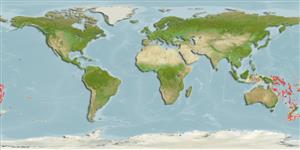Actinopterygii (ray-finned fishes) >
Gadiformes (Cods) >
Macrouridae (Grenadiers or rattails) > Macrourinae
Etymology: Hymenocephalus: Named for its transparent membrane-like head covering (‘‘hymen head’’) and fragile nature of head bones (Ref. 100825); megalops: From the Greek megas, great, and ops, eye, in reference to the notably large eyes of the species.. More on author: Iwamoto.
Environment / Climate / Range
Ecology
Marine; benthopelagic; depth range 600 - 825 m (Ref. 35908). Deep-water, preferred ?
Western Central Pacific: known only from New Caledonia and off Queensland, Australia.
Size / Weight / Age
Maturity: Lm ? range ? - ? cm
Max length : 17.0 cm TL male/unsexed; (Ref. 35908)
Short description
Morphology | Morphometrics
Dorsal
spines
(total): 2. Gill rakers first arch (outer/inner) 12-19/20-24; barbel short 8-22% HL; orbits large 40-48%; snout usually 23-33%; orb.-preop. 36-7%; dorsolateral stripe on trunk fades out completely on tail.
A benthic species found on the continental slope (Ref. 75154).
Life cycle and mating behavior
Maturity | Reproduction | Spawning | Eggs | Fecundity | Larvae
Iwamoto, T. and N.R. Merrett, 1997. Pisces Gadiformes: Taxonomy of grenadiers of the New Caledonian region, southwest Pacific. Mem. Mus. Natl. Hist. Nat. (176):473-570. (Ref. 35908)
IUCN Red List Status (Ref. 115185)
CITES (Ref. 94142)
Not Evaluated
Threat to humans
Harmless
Human uses
More information
Common namesSynonymsMetabolismPredatorsEcotoxicologyReproductionMaturitySpawningFecundityEggsEgg development
Age/SizeGrowthLength-weightLength-lengthLength-frequenciesMorphometricsMorphologyLarvaeLarval dynamicsRecruitmentAbundance
ReferencesAquacultureAquaculture profileStrainsGeneticsAllele frequenciesHeritabilityDiseasesProcessingMass conversion
Tools
Special reports
Download XML
Internet sources
